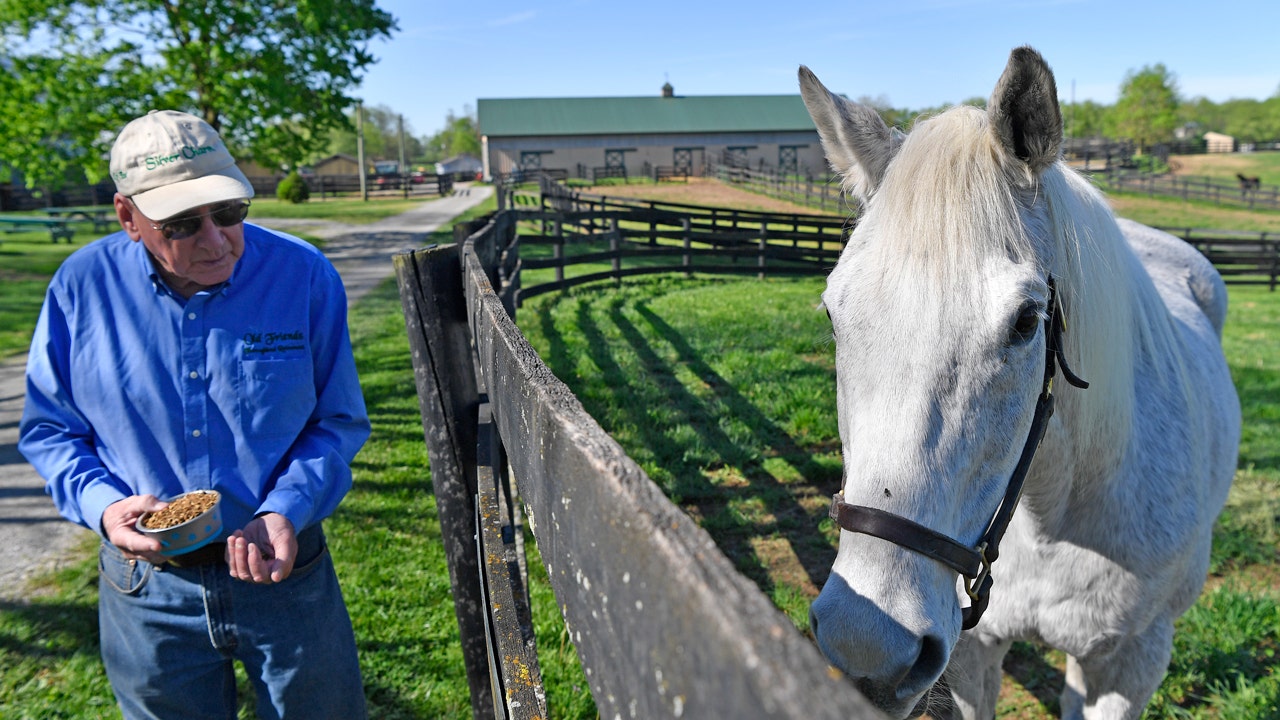Skimming over miles of hills blackened by wildfires west of Athens, Fire Lt. Col. Ioannis Kolovos readies his elite fire crew crouched inside a helicopter.
The 10-member group from the 1st Wildfire Special Operation Unit bristles with tools needed to hold back fires: chainsaws, specialized rakes, weather gauges, computer tablets and earth-scorching drip torches to burn wildfire barriers into the hillside.
Greece’s fire season officially starts May 1, but dozens of fires have already been put out over the past month after temperatures began hitting 86 degrees Fahrenheit in late March — considerably higher than previous spikes recorded over the past decade.
5 FORMER OFFICIALS CONVICTED IN GREECE’S DEADLIEST WILDFIRE CASE
“It’s actually already summer for us,” Kolovos told The Associated Press during a recent training exercise. “The truth is that the fire season has started prematurely and has been extended over the last five years.”
Firefighters of the 1st Wildfire Special Operation Unit, take part in a drill near Villia village about 37 miles northwest of Athens, Greece, on April 19, 2024. Under pressure to cope with the impact of rising temperatures, Greece’s emergency response planners are shifting tactics this summer. (AP Photo/Thanassis Stavrakis)
This year, Greece is doubling the number of firefighters in specialized units to some 1,300, and adopting tactics from the United States to try and outflank fires with airborne units scrambled to build breaks in the predicted path of the flames.
Crew members include forestry experts and firefighters with varied skills, many developed in training with colleagues in France, Spain and the United States.
“We can position ourselves in optimal locations that may be difficult to reach by foot and carry out fire suppression using various specialized methods,” Firefighter Dimitris “Jim” Priftis said while assisting trainees in a region near the capital ravaged by wildfires in summer 2023.
“Using water is no longer our main weapon against fires, it’s our tools,” he said. “We are taking a more scientific approach toward fires, measuring the humidity, the wind — it’s a more planned method.”
WILDFIRE RESPONSE PLANS OVERHAULED IN GREECE AHEAD OF SUMMER FIRE SEASON
Mostly funded by the European Union, Greece has launched a $2.3 billion program to overhaul its disaster response capability, ordering new water-dropping aircraft, drones, fire trucks, training facilities, and an artificial intelligence-driven sensor network to detect early signs of smoke and flooding.
But the new equipment won’t start arriving until 2025. Greek authorities are doubling down on training and new firefighting methods, with another tough season expected this year.
Fires burned an estimated 1,750 square kilometers (675 square miles) last year, including a blaze in northern Greece that was the worst fire ever recorded in the European Union.
Windy and mountainous with hard-to-reach islands, Greece faces a daunting annual challenge in defending multiple urban settlements that overlap with wooded areas at wildfire risk.
It’s also getting hotter: Last winter was the warmest since modern records began in 1960, according to the National Observatory of Athens, which analyzed European Union satellite data. The six warmest Greek winters on record have occurred in the past decade.
That’s against the backdrop of new data revealing that Europe is the world’s fastest-warming continent, its temperatures rising at roughly twice the global average.
Standing in the main disaster response command center in Athens, Vassilis Kikilias, the minister for climate crisis and civil protection, says authorities expect annual conditions to worsen further.
“It will be a very difficult fire season, a very difficult summer,” Kikilias, a towering former pro basketball player, told the AP in an interview. “We had a dry winter and fall temperatures lasting until December. So we’re facing the climate crisis head on.”
Throughout the month of April, firefighters stepped up exercises and training, using new facilities like the Fire Dragon, a $1.3 million trailer used to simulate the inside of a burning building. Fire crews with heavy protective gear and oxygen tanks use it to practice close-quarter techniques and rescues.
Close by, Fire Service regulars and trainees crawl through a mesh maze in darkness to practice working in confined spaces. Participants in full kit first workout on treadmill climbers and other gym machines, then crawl through the maze as strobe lights, smoke and loud noises are added to disorient them.
“The firefighting maze helps firefighters in a dark environment, in an unfamiliar setting, in the presence of fire, to enter the area, investigate, possibly carry out a rescue and find a way out,” said Fire Lt. Col. Vrasidas Grafakos, a training center commander.
“It’s to train them effectively to be ready for building fires, for front-line activity.”
Retiree Chrysoula Renieri was among those who lost their homes in the 2023 fires that tore through forests on the island of Rhodes, in northeastern Greece, and areas west of Athens.
Renieri visited her gutted house last week. As she walked through the blackened rooms, she described how her family felt helpless as the approaching fire cut off power and the water supply before the flames took over the house. “No one helped us and everything burned. It’s all gone.”
She said she hopes the Fire Service’s new equipment and methods might make a difference to others.
“I wish that would happen, so many homes could be saved,” she said. “We hope, because summer is coming again and the torment will begin.”



